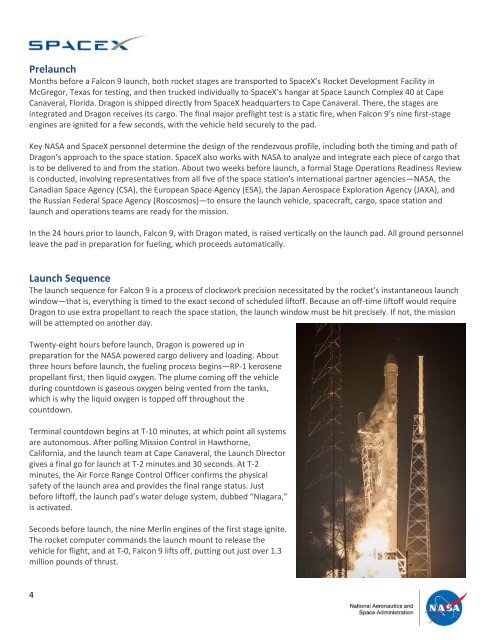spacex_nasa_crs-6_presskit
You also want an ePaper? Increase the reach of your titles
YUMPU automatically turns print PDFs into web optimized ePapers that Google loves.
Prelaunch<br />
Months before a Falcon 9 launch, both rocket stages are transported to SpaceX’s Rocket Development Facility in<br />
McGregor, Texas for testing, and then trucked individually to SpaceX’s hangar at Space Launch Complex 40 at Cape<br />
Canaveral, Florida. Dragon is shipped directly from SpaceX headquarters to Cape Canaveral. There, the stages are<br />
integrated and Dragon receives its cargo. The final major preflight test is a static fire, when Falcon 9’s nine first-stage<br />
engines are ignited for a few seconds, with the vehicle held securely to the pad.<br />
Key NASA and SpaceX personnel determine the design of the rendezvous profile, including both the timing and path of<br />
Dragon’s approach to the space station. SpaceX also works with NASA to analyze and integrate each piece of cargo that<br />
is to be delivered to and from the station. About two weeks before launch, a formal Stage Operations Readiness Review<br />
is conducted, involving representatives from all five of the space station’s international partner agencies—NASA, the<br />
Canadian Space Agency (CSA), the European Space Agency (ESA), the Japan Aerospace Exploration Agency (JAXA), and<br />
the Russian Federal Space Agency (Roscosmos)—to ensure the launch vehicle, spacecraft, cargo, space station and<br />
launch and operations teams are ready for the mission.<br />
In the 24 hours prior to launch, Falcon 9, with Dragon mated, is raised vertically on the launch pad. All ground personnel<br />
leave the pad in preparation for fueling, which proceeds automatically.<br />
Launch Sequence<br />
The launch sequence for Falcon 9 is a process of clockwork precision necessitated by the rocket’s instantaneous launch<br />
window—that is, everything is timed to the exact second of scheduled liftoff. Because an off-time liftoff would require<br />
Dragon to use extra propellant to reach the space station, the launch window must be hit precisely. If not, the mission<br />
will be attempted on another day.<br />
Twenty-eight hours before launch, Dragon is powered up in<br />
preparation for the NASA powered cargo delivery and loading. About<br />
three hours before launch, the fueling process begins—RP-1 kerosene<br />
propellant first, then liquid oxygen. The plume coming off the vehicle<br />
during countdown is gaseous oxygen being vented from the tanks,<br />
which is why the liquid oxygen is topped off throughout the<br />
countdown.<br />
Terminal countdown begins at T-10 minutes, at which point all systems<br />
are autonomous. After polling Mission Control in Hawthorne,<br />
California, and the launch team at Cape Canaveral, the Launch Director<br />
gives a final go for launch at T-2 minutes and 30 seconds. At T-2<br />
minutes, the Air Force Range Control Officer confirms the physical<br />
safety of the launch area and provides the final range status. Just<br />
before liftoff, the launch pad’s water deluge system, dubbed “Niagara,”<br />
is activated.<br />
Seconds before launch, the nine Merlin engines of the first stage ignite.<br />
The rocket computer commands the launch mount to release the<br />
vehicle for flight, and at T-0, Falcon 9 lifts off, putting out just over 1.3<br />
million pounds of thrust.<br />
4


